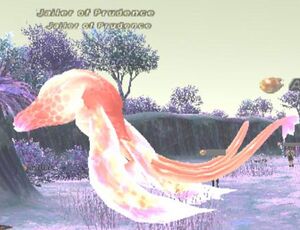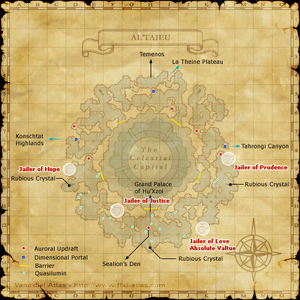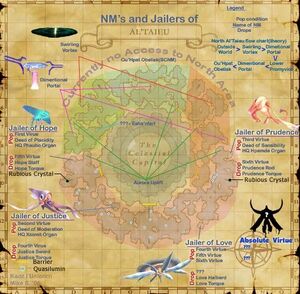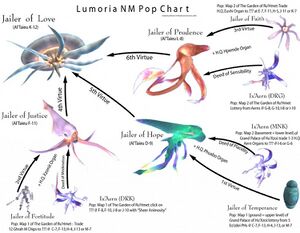Jailer of Prudence: Difference between revisions
(→Notes:) |
No edit summary |
||
| (One intermediate revision by the same user not shown) | |||
| Line 60: | Line 60: | ||
:* The strategy on HorizonXI seems to be have a Thief (or someone with Movement+) outside of the Alliance, have that person pop the Jailer, flee, and have your tank Flash/Provoke to pull the unclaimed one off the person popping it. You don't have to zone, its actually more beneficial here to run the duration of Flee in whatever direction and just die/warp. The Jailer will go back to the ??? VERY slowly and after 3 minutes he will despawn (He seems to only cover about 40 yalms during this 3 minutes). The other Jailer that you're killing's mouth will open and you're freely able to kill it at this point. | :* The strategy on HorizonXI seems to be have a Thief (or someone with Movement+) outside of the Alliance, have that person pop the Jailer, flee, and have your tank Flash/Provoke to pull the unclaimed one off the person popping it. You don't have to zone, its actually more beneficial here to run the duration of Flee in whatever direction and just die/warp. The Jailer will go back to the ??? VERY slowly and after 3 minutes he will despawn (He seems to only cover about 40 yalms during this 3 minutes). The other Jailer that you're killing's mouth will open and you're freely able to kill it at this point. The person who pops the Jailer should stay out of the alliance at least until the other Jailer depops to prevent shared alliance threat with the team killing the other one. {{changes}} | ||
Latest revision as of 12:57, 4 June 2024
| Zone | Level | Drops | Steal | Spawns | Notes |
|---|---|---|---|---|---|
| Al'Taieu | 85 | 2 | A, L, T(H) ??? HP | ||
|
HP = Detects Low HP; M = Detects Magic; Sc = Follows by Scent; T(S) = True-sight; T(H) = True-hearing JA = Detects job abilities; WS = Detects weaponskills; Z(D) = Asleep in Daytime; Z(N) = Asleep at Nighttime; A(R) = Aggressive to Reive participants | |||||
Notes:
- Spawned by trading Third Virtue, Deed of Sensibility, and High-Quality Hpemde Organ to the "???" at (L-8). Please note that two NMs named Jailer of Prudence spawn at the same time.
- To obtain drops, both Jailers of Prudence need to be defeated. The first one never drops any items. The second one is always the one to drop items.
- If both versions die at the same time in "closed-mouth" form, it is possible for them to drop nothing at all.
- Both will despawn 3 minutes after it deaggros.
- If the first one despawns, as long as the second one is still up, it will behave as if the first was killed (the second one's mouth will open, it WILL drop items).
- Each one disappears (becomes untargetable and invisible) when hate shifts to a player outside its melee radius, and reappears next to the person at the top of its hate list.
- Both of them can and will Triple Attack frequently.
- Both can use Perfect Dodge multiple times, and will do so almost incessantly. Melees are ineffective, unless they use Spirits Within or Chi Blast on this Jailer for this reason. On average every 10% health lost Prudence uses Perfect Dodge.
- Seems to be immune to Elegy - wasn't able to get it on JoP - even with Elemental Seal.
- The pair uses normal Hpemde abilities. When they are in close proximity, the two will use these abilities in sync.
- JoP has alliance hate, so any strategy that involves kiting one away should have someone outside the fighting alliance pop the NMs.
- They do not have increased movement speed over normal Hpemde, and they "swim" in the same fashion, so kiting one image around the island southwest of the spawn point while the other one is manaburned near the spawn area is a preferred tactic.
- Jailer of Prudence will however gain Flee speed during Perfect Dodge. He will also occasionally (always?) have Flee speed when popped.

- Once the first "copy" of Jailer of Prudence is defeated, the second one will go into the Hpemde family's characteristic "open-mouth" form. In this form its defenses are reduced, but its melee attacks are extremely potent. A common strategy is to kite the second copy until the alliance is prepared to engage it, and then defeat it as fast as possible with high-damage spells and ranged attacks.
- There used to be problems with this NM including one or both becoming untargetable but still attacking people; and one becoming both untargetable and invisible, but not despawning. It was possible to bring other enemies near the Jailer and defeat it with AoE spells. (Note: These issues were addressed as of the February 2006 update.)
- The strategy on HorizonXI seems to be have a Thief (or someone with Movement+) outside of the Alliance, have that person pop the Jailer, flee, and have your tank Flash/Provoke to pull the unclaimed one off the person popping it. You don't have to zone, its actually more beneficial here to run the duration of Flee in whatever direction and just die/warp. The Jailer will go back to the ??? VERY slowly and after 3 minutes he will despawn (He seems to only cover about 40 yalms during this 3 minutes). The other Jailer that you're killing's mouth will open and you're freely able to kill it at this point. The person who pops the Jailer should stay out of the alliance at least until the other Jailer depops to prevent shared alliance threat with the team killing the other one.

- The strategy on HorizonXI seems to be have a Thief (or someone with Movement+) outside of the Alliance, have that person pop the Jailer, flee, and have your tank Flash/Provoke to pull the unclaimed one off the person popping it. You don't have to zone, its actually more beneficial here to run the duration of Flee in whatever direction and just die/warp. The Jailer will go back to the ??? VERY slowly and after 3 minutes he will despawn (He seems to only cover about 40 yalms during this 3 minutes). The other Jailer that you're killing's mouth will open and you're freely able to kill it at this point. The person who pops the Jailer should stay out of the alliance at least until the other Jailer depops to prevent shared alliance threat with the team killing the other one.
Dialogue
The "???" at (L-8) says:
"Seeketh...thou?
Thir...irtue
Deed...rationa...
...receptac...from Hpem...
...cannot...omprehend...them"
The fragmented dialogue is referring to the Third Virtue, the Deed of Sensibility (rationality), and a HQ Hpemde Organ (receptacle from a Hpemde).
Historical Background
The Heavenly Virtues
The 7 Jailers of Sea are based on the 7 Virtues. Virtue is defined as moral excellence. Virtue can accordingly be characterized as having desirable character traits, traits which direct a person to act in accord with the best possible standard. In other words, Virtues improve us towards the idealized perfection of our being. In order to be virtuous, one must continuously have virtues as habits of their character. The idea of Virtues originate with the ancient Greeks and the idea was later picked up and made a part of Christian moral theology, probably during the Medieval era. There are 2 sets of virtue: the cardinal virtues (sometimes called the classical virtues) & the theological virtues. The former originate with the ancient Greeks and the latter originates in the Bible (New Testament), specifically 1 Corinthians 13, but became popular in Medieval Christianity. The cardinal virtues are: Prudence/Wisdom, Justice, Fortitude/Courage, Temperance. The theological virtues are: Faith, Hope, Charity/Love. Together, these seven virtues were called the Heavenly Virtues or simply the Seven Virtues. The pairing of these seven virtues appeared to have originated with 13th century Christian philosopher Thomas Aquinas in his work "Summa Theologica". They became a popular element for depiction in the Medieval and Renaissance periods.
According to ancient Greek philosophy, they viewed each Virtue as being the mean on a spectrum of some characteristic. As such, each Virtue would have 2 vices associated with it, lying at the extremes of that spectrum. Note that the Virtue was the mean, not necessarily the median between both vices. According to Medieval Christian thought, these virtues are said to improve one's love of God and Man. The cardinal virtues are dispositions of one's being which govern one's actions, restrain their passions and guide their conduct in accordance with reason. The theological virtues are said to give Christians the ability to live in a relationship with the Holy Trinity. They are considered to give life to all the moral virtues (the cardinal and theological virtues). The Heavenly Virtues are generally limited to the Roman Catholic denomination of Christianity. It should be noted the Chinese, Muslim, and other cultures have different sets of virtues.
The seven Heavenly Virtues do not align up with the Seven Deadly Sins. The seven Holy Virtues (or Contrary Virtues) do though, which are: Humility (counters Pride), Kindness (counters Envy), Patience (counters Wrath), Abstinence (counters Gluttony), Chastity (counters Lust), Liberality (counters Greed), Diligence (counters Sloth).
The Virtue of Prudence
Prudence (Prudentia) is one of the Virtues. It is a cardinal virtue which originated with the ancient Greeks and was adopted by Christianity, though Prudence is the Christian Medieval rendering of it. The ancient Greeks called this virtue Wisdom (though Christians had associated it with wisdom too). Prudence means to exercise sound judgment in practical affairs, which meant the ability to discern what is proper in a situation or overall. Roman philosopher Seneca called Prudence the "perfect virtue", stating a perfectly prudent person would act in the same way as a perfectly virtuous person would (though the Greeks considered Justice as the master virtue).
To the ancient Greeks, Wisdom (Sophia or Phronesis [which translates as "practical wisdom"]) gave the ability to deliberate and think about decisions in life and to make the right choice. It consisted of good thought and good judgment. Wisdom was the mean between overcaution and heedlessness or recklessness. They considered Wisdom to be the virtue of the rational part of the human soul (which was represented as a human being). To Medieval and Renaissance-era Christians, Prudence was the Virtue which gave people the reason to discern what is the Good, what is the good course of action in each circumstance and the reason to discern what is the right means of achieving that good. It guided the judgment of the mind. Prudence allowed one to see through falsehood and discern what is the true path and what is the false path. It was called the auriga virtutum ("the charioteer of the virtues") since it guides the other virtues by setting the framework for them to operate in. They believed Prudence was accompanied by the gift of counsel and would challenge the vices of impudence and negligence.
In Medieval and Renaissance art, Prudence is frequently depicted as a calm-expressioned woman holding a bundle of live snakes with one hand and a small handheld mirror with the other hand. If the serpents were not in her hand, they were shown laying coiled up elsewhere in the scene. The serpents were said to symbolize wisdom (a classic association). Occasionally, Prudence would be shown with 2 faces, one in the normal position and the other on the back of her head. This manner of depiction explains why a Hpemde-type monster was chosen (it is partially serpentine) and why 2 Jailers of Prudence pop at once (the two faces). The mirror also resembles a rod, which would explain the Prudence Rod being the item of choice.
The Jailers of Sea
It is not clear what the proper context of the Jailers is. "Jailer of (Virtue)" can be taken two ways. First, it can imply they are the Jailer of (Virtue), imprisoning that Virtue (or more specifically, imprisoning one aspect of Absolute Virtue). This would mean they do not possess the Virtue, they jail it. Second, it can imply they are the Jailer of (Virtue), being a jailer possessing that virtue. This would mean they are a jailer which possesses the Virtue in question. In this case, they would not be jailing the Virtue in their name, they would be jailing the monster known as Absolute Virtue. The latter interpretation is more logical since each Jailer drops a weapon and a torque bearing their namesake Virtue. If they were to be jailing the Virtue in question, it would make more sense for them to drop weapons and torques not named after the virtue, like objects named after the 7 Vices or the 7 Sins. Since the title you gain for defeating Absolute Virtue is "Virtuous Saint," this is the more widely accepted context. However, the former also makes sense because if the jailer is defeated, the virtue it was imprisoning is released. Absolute Virtue, interestingly, appears to drop 7 items named after synonyms for the deadly sins. It may drop these sins because upon defeating Absolute Virtue you theoretically destroy all the virtues, leaving the only thing left to gain to be sins. It is also possible that the sins are the "chains" placed on Absolute Virtue.
* Sin of Indignation (wrath) * Sin of Insolence (pride) * Sin of Indulgence (greed) * Sin of Infatuation (lust) * Sin of Indolence (sloth) * Sin of Invidiousness (envy) * Sin of Intemperance (gluttony)




